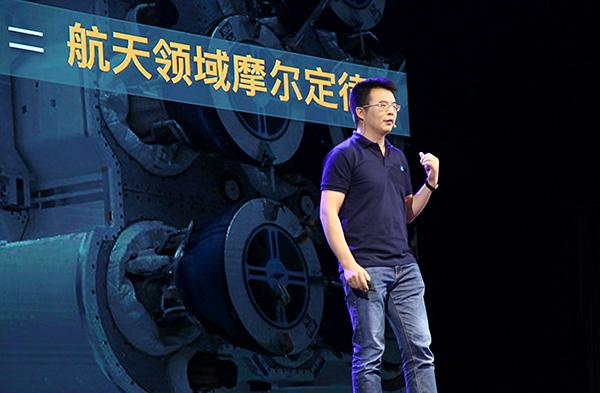Xie Tao, CEO Of Jiutian MSI: If You Catch The Platinum Asteroid, It Will Be Worth $5.4 Trillion
Xie Tao, CEO Of Jiutian MSI: If You Catch The Platinum Asteroid, It Will Be Worth $5.4 Trillion
Future detectors can 3D print and replicate themselves, and space mining can mine platinum asteroids worth $5.4 trillion in minerals...Recently, Xie Tao, CEO of Beijing Jiutian MSI Technology Development Co., Ltd. (hereinafter referred to as
Future detectors can 3D print and replicate themselves, and space mining can mine platinum asteroids worth $5.4 trillion in minerals...
Recently, Xie Tao, CEO of Beijing Jiutian MSI Technology Development Co., Ltd. (hereinafter referred to as "Jiutian MSI"), described the application prospects of future space technology at the "2018 Youth Shanghai·Crafting" speech.

Xie Tao
Xie Tao, who has worked in China Aerospace Science and Technology Corporation, the State Administration of Defense Technology and Industry for more than 10 years, broke out of the system in 2014 and founded Jiutian MSI the next year. This is a satellite startup that engages in innovative applications of micro satellites and constellation network operations. On February 2, 2018, the first satellite independently developed by Jiutian MSI, "Shao Nian Star One", successfully "goes to the sky".
"Elon Musk said that we may live in a game or virtual world where we live in a real world with only one in a billion. Should we be curious and see what is outside, we What kind of world do you live in and where will you go in the future?”
Immigration to Mars, space mining, interstellar travel, and search for a second earth will allow human civilization to continue. Commercial aerospace startups are bold in their brains.
Xie Tao said that in 2020, MSI will launch a small satellite to detect platinum asteroids. "NASA (NASA) has made an estimate for it (platinum asteroids). How much is this piece of gold worth? ? About $5.4 trillion." The small satellite flew three years to approach the platinum asteroid. "It takes another year to build three-dimensionally, and the whole process will take 4 years."
"This industry is different from the Internet. It has been launched in three or four years, and we may have only launched one small satellite. But once we succeed, this small satellite is still very valuable."
To detect extraterrestrial civilizations, detectors that can 3D printing, self-replicate, and have artificial intelligence will also be invented in the future. First launch a probe like this to an adjacent planet and let it detect whether there are extraterrestrial civilizations on this planet. "If there is, it sends the signal back; if there is no, it takes materials locally, 3D prints the same self, and flies to another planet. And so on, one becomes two, two becomes four, four becomes eight... …This is the fastest and most economical way to realize extraterrestrial civilization detection.”
Xie Tao talked about Elon Musk. Founded Tesla and Space X, and used engines from the 1960s and 1970s given by NASA, and achieved recyclability of rockets under the control of IT systems. "The cost per time is reduced by 30%. After accumulating, the cost index of entering space will be entered "Musk brought Moore's Law in the IT field into space, and Xie Tao called him a disruptor in the commercial aerospace field. "He lets everyone see a startup company that can also do space."
"IT is often led by entrepreneurial and dynamic small companies. It has Moore's Law iterated rapidly, with the participation of the whole people, and continuously formed an ecosystem of industrial chains and applications. Aerospace is still dominated by the government and large companies and entered the industry. The risks and trial and error cost are very high. "This is why rockets are expensive nowadays, and our mobile phone computing power can be higher than most satellites in the sky.
There is an idiom called Tianluodi Net.
In the 1960s and 1970s, Skynet overwhelmed the ground network, and GPS used 36 satellites to provide "daily navigation for billions of people and tens of billions of terminals around the world."
Twenty or thirty years later, the Earth Net defeated the Sky Net. Although Motorola launched the Iridium project, intending to form a constellation with 77 satellites to achieve the scene of calling anyone at any time and anywhere, this "great scientific project" was still overshadowed by ground fiber optics. At that time, ground fibers achieved rapid development, and later submarine optical cables were established, and the ground transmission cost was greatly reduced and the distance was greatly opened. "At this time we started using 2G, 3G, and 4G."
"What we are about to enter the 5G era. I don't think it's anyone who defeats whom, but a convergence of Skynet and Earthnet." Xie Tao said that Earthnet has its advantages in densely populated areas, but at present, "ground base station coverage" The area is less than 10% of the earth's surface, and half of the world's 7 billion people do not have Internet access." To connect remote tribes to WIFI, connect everything, and achieve asset monitoring in a wide area and sparsely populated areas, the integration of aerospace and IT is the future trend. "Use the advantages of satellites to improve the dimension and height of IT, and achieve integration and complementarity with the ability to use satellites to improve the dimension and height of IT, so as to achieve integration and complementarity .”
The following is the transcript of the speech:
Cognition is the only weapon for human progress. Now I will take you to refresh your understanding of commercial aerospace and space exploration.
I want to start with Elon Musk, who is known as the Iron Man of Silicon Valley and founded Tesla and Space X. He is a disruptor in our industry, he has realized recyclable rockets, and what he is doing is launching 12,000 satellites to enable Wi-Fi connections anywhere and anywhere in the world. His ultimate goal is to turn humans into transplanetary species and immigrate to Mars.
Many people have summarized his success. I think in one sentence, he uses IT ideas to do aerospace. His recyclable rocket was given to him by NASA in the 1960s and 1970s. The engine generates reverse thrust by burning fossil energy, without qualitative changes. But he used a bunch of engines to connect in series and parallel, and used a good IT control system to make the rocket stable and recyclable and land smoothly. And the cost per time is reduced by 30%, but over time, the cost of entering space will drop exponentially. Therefore, he brought Moore's Law in the IT field into space and rejuvenated this field.
Let’s review the development of IT and aerospace.
Two major events happened in 1946. One was the IT industry, and the first computer was born. In the same year, the United States established the "Aerospace Commission", which is known as the beginning of the modern aerospace industry. The United States inherited the legacy of Germany during World War II, grabbed the experts who made missiles from the United States, and began the technical research on turning missiles into rockets.
More than 20 years have passed. In 1969, two major events happened in the scientific community coincidentally. First, Apa.com was born, which is the originator of the Internet. In the same year, a great exploration in human history was completed, that is, Apollo's lunar exploration. So far, this is the most shocking breakthrough in human history. Since then, people have had a lot of fantasies about both fields. IT makes the world better, while aerospace is looking for more such a beautiful world.
More than half a century later, IT has profoundly changed our lives and has now developed into AI. Elon Musk also said that we must be very careful about artificial intelligence, which may be more dangerous than nuclear weapons. However, aerospace is still high above, and can be viewed from a distance but not played close to it. Logically, in our era, can everyone go to the moon and travel?
In 1946, the Rockets cost as much as computers at the time, but now the Rockets are expensive. The mobile phone in the hand here has higher computing power than most satellites in the sky. Why is this?
We summarized that IT is often led by entrepreneurial, dynamic small companies. It has Moore's Law iterated rapidly, with the participation of the whole people, and continuously forming an ecosystem of industrial chains and applications. Aerospace is still dominated by the government and large companies, and the risks of entry and trial and error are very high. Few startups can work here.
This is the value of Space X, which allows everyone to see a startup company that can also do aerospace. So we entered a new age of space. Under his leadership and transformation, we see that people in Silicon Valley who engage in IT and the Internet have been invested in this field. For example, Bezos, who founded Blue Origin and sold $1 billion worth of stock from Amazon every year to invest in his dream. The Microsoft co-founder also worked as a space travel company, and the Google founder is committed to the development of space resources.
Is many people investing in this field just for their feelings? I believe there is. But how to make money and how to develop sustainably?
A large number of technological transformations have been made in the aerospace field. For example, the digital cameras, diapers, and vacuum packaging products we use today are all transformed from aviation technology. In IT-related fields, the most we use is satellite applications. There is an old saying called "The Net of Heaven and Earth". The 1960s and 1970s were the era of navigation and positioning. Skynet overshadowed the earth network. Our GPS, using only 36 satellites, can provide billions of people and tens of billions of terminals around the world, and every second is provided. Poor navigation. It also extends a series of LBS location-based services, such as Didi and Takeaway, which are all business models based on satellite positioning. This is the first era, and we use Skynet to provide daily services.
The second era was the 1990s, which was the era of mobile communications, and the local network won this time. At that time, we started using this landline or mobile phone communication. In addition to ground base stations, many people have also invested in low-orbit constellation plans. The most representative one is Motorola, which launched an Iridium project, which uses 77 satellites to form a constellation and can call anyone at any time and anywhere. It was indeed a great scientific project to be able to do this in the 1990s. So much so many companies make products that are simply toys compared to Iridium. But at this time, ground fibers achieved rapid development, greatly reduced costs and greatly opened up, and later submarine optical cables were realized, and the cost and transmission distance of the ground were greatly improved. At this time, we started to use 2G, 3G, and 4G .
What we are about to enter the 5G era. I think it is not who defeats who, but a fusion of Skynet and Earthnet. The ground network has its advantages in densely populated areas. But from a global perspective, we have ground base stations covering less than 10% of the earth's surface. Half of the world's 7 billion people do not have access to the Internet. In the future, we are another era of the interconnection of everything, including ships, containers, airplanes, drones, and a large number of assets in the vast and sparsely populated areas. If these are to be connected to the Internet, it is necessary to integrate Skynet and Earthnet. , achieve integrated coverage of the world. Therefore, we must use the advantages of satellites to improve the dimension and height of IT and achieve integration and complementarity.
Therefore Space X issued a Starlink project to wrap our earth tightly with 12,000 satellites. If it can be implemented successfully, the significance is that, like remote tribes in Africa, we use a laptop-sized antenna, connected to a satellite, as a WIFI hotspot, covering a range of 3-5 kilometers, and the cost is only three to five hundred dollars. Such low cost allows very backward areas to access the Internet world. What we are doing is 5G narrowband IoT, first using 72 satellites to achieve the interconnection of the massive Internet of Things worldwide. On this basis, we will be a broadband constellation because it requires higher costs.
Therefore, based on such opportunities, the world has set off a second wave of space races. This competition was led by commercial aerospace companies and many constellations were planned.
Carl Sagan said that the planet we live in is a lonely dust wrapped in this dark universe, and all our love, hate, and sorrows occur on this dust. If there is any disaster happening to us, no one will come to save us in the foreseeable future.
Elon Musk said that it is possible that we live in a game or virtual world where we live in a real world with only one in a billion.
Should we be curious and see what is outside, what kind of world we live in, and where will we go in the future?
We will definitely go outside and take a look. We immigrate to Mars, space mining, interstellar travel, and find a second earth to allow human civilization to continue. We can't predict these, but one thing is certain that our aerospace technology will work together with IT technology or AI to move towards the future. Only in this way can humans have a chance.
The company is now doing several directions, one is how to use AI to reduce the cost of spacecraft. In the past, we called "Ten Years of Sharpening One Sword", and in the future, we can produce 3-4 small satellites a day. Through batching and intelligence, the cost of spacecraft is reduced.
Second, the application of satellite AI. Our original remote sensing was to take a lot of photos and send them back to the earth, identify them on the ground, and then provide agricultural, forestry, animal husbandry, fishery or climate services. In the future, we will use AI chips directly, plus remote sensing satellites, and we can directly see what happened on the ground in the sky, and immediately lose this result, turning our satellite from the eyes of the sky into the brain of the sky. For example, we see that the agricultural growth in this area has been affected by pests. The data is coming down immediately and we can take all actions.
Third, in the future, we will use low-cost small satellites to conduct asteroid exploration. The target of the detection is space assets, such as platinum asteroids. NASA gave him an estimate of how much is this piece of gold worth? About $5.4 trillion. Another type is high-risk asteroids. We can monitor how many asteroids in space will hit the earth. We can monitor, prevent, and influence it to prevent it from hitting the earth. There is another type of asteroids that implies the codes of the origin of our solar system and the earth, and we can detect the codes of the origin of human beings.
We plan to launch a small satellite in 2020 to detect Platinum. It will take about 3 years to fly to get close to this asteroid. It will take another year to construct three-dimensionally and suspend it on it. The whole process will take 4 years.
This industry is different from the Internet. It has been launched in three or four years, and we may have only launched one small satellite. But once we succeed, this small satellite is still valuable. So, having patience to do our job is a marathon.
Scientists have imagined a detector to detect whether a galaxy has civilization, and this kind of detector can be completely self-replicated. We first launch a probe like this to an adjacent planet, and it will detect whether there are extraterrestrial civilizations on this planet. If there is, it sends the signal back; if there is no, it takes materials locally, 3D prints the same self, and flies to another planet. By analogy, one will change from two, two will change from four, four will change from eight... This detector is actually an artificial intelligence robot. This may be the fastest way to find out the universe we are in, to see if we are lonely, whether we have similarities, and whether there are extraterrestrial civilizations.
This is what I want to say. Not only will there be technological breakthroughs in aerospace, but also various artificial intelligence technologies to help us move towards the extraordinary future of our mankind.
This is the end of my speech today, thank you everyone.




